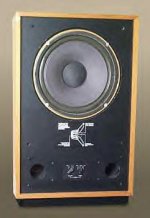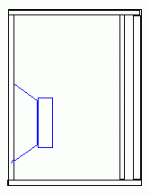I a remaking my Tannoy Berkerley cabinets to include external crossovers in a seperate stand/cabinet to go undernreath the driver cab.
I want to brace it internally as the dimensions are fairly large (standard cabinet!) and am worried about the flexibility of the main sides.
If I put in a cross section brace will it have an effect on internal reflections?Would I be better of adding some odd angles (maybe a triangular brace? back-to-front-to-back?
I want to brace it internally as the dimensions are fairly large (standard cabinet!) and am worried about the flexibility of the main sides.
If I put in a cross section brace will it have an effect on internal reflections?Would I be better of adding some odd angles (maybe a triangular brace? back-to-front-to-back?
Just add a brace from side to side and I sit this on driver cutouts (a good use for them) as they help even more. I use different sizes for each side.... that assymetrical thinking  Have it a bit higher or lower than half way and it really helps with the panel resonances.
Have it a bit higher or lower than half way and it really helps with the panel resonances.
Could always add a 45° panel at the bottom as shown in the picture and if the volume is needed add holes in it. Nasty sound reflections could go down there and bounce they way to oblivion ... maybe.... bit like a B&W tapered tube?
... maybe.... bit like a B&W tapered tube?
Whoops.... better add the pic.
Could always add a 45° panel at the bottom as shown in the picture and if the volume is needed add holes in it. Nasty sound reflections could go down there and bounce they way to oblivion
Whoops.... better add the pic.
Attachments
My main reason for asking is that the front and rear panels of this speaker are 500mm x 754mm. They are pretty big panels.
And as the driver is 15inches across is has a large cone area to receive internal standing waves.
Although the sound is fantastic the bass could do with tightening up a little and I think this may have something to do with internally reflected standing waves.
Any ideas welcome
And as the driver is 15inches across is has a large cone area to receive internal standing waves.
Although the sound is fantastic the bass could do with tightening up a little and I think this may have something to do with internally reflected standing waves.
Any ideas welcome
'high performance loudspeakers' by martin colloms and
'the loudspeaker and headphone handbook'
I think one of these atleast has a good section on enclosures,with measurements on enclosure output vs driver output!
High mass enclosures dont damp resonances, 9mm+ thick bitumen layer is reccomended for damping.
By all means use bracing to divide resonances in to unequal dimensions/frequencies to prevent summation.
Also noted,is an extra internal baffle 3-4cm inward of the rear baffle,helps things,the T section is stronger.[cant remember which book exactly]
'the loudspeaker and headphone handbook'
I think one of these atleast has a good section on enclosures,with measurements on enclosure output vs driver output!
High mass enclosures dont damp resonances, 9mm+ thick bitumen layer is reccomended for damping.
By all means use bracing to divide resonances in to unequal dimensions/frequencies to prevent summation.
Also noted,is an extra internal baffle 3-4cm inward of the rear baffle,helps things,the T section is stronger.[cant remember which book exactly]
Attachments
Qoute from Jay:
You could add a brace that supports the motor of the woofer and attaches to the side panels (SL has promoted this idea on his website) as this would re-inforce the side panels as well as decreasing baffle vibrations.
Jay
end of Quote.
I own a set of Tannoy K3808's. 15" dual-concentrics as well. I have succesfully taken the same approach as Jay mentions.
You simply take a panel (I used 24mm thick MDF) that fits exactly within the inside of the cabinet. Then you draw a circle where the magnet will pass through. Cut it out slightly conical for the Tannoy Magnet to sit in nice and tight!
Then draw out somewhat curved shapes in such a way that after cutting them out, you will be left with somewhat of an X-shape with a hole where the magnet stick through.
Beware that it might seem obvious to coat the inner side of the hole with rubber. But this is not wise, since it leaves th possibility for unwanted resonances. I used loose BAF just for not scratching my beloved chassis, and put the X-shape slightly too much forward, as to get everything as tight together as possible. This happens after drying, when you screw back the chassis again.
You could add a brace that supports the motor of the woofer and attaches to the side panels (SL has promoted this idea on his website) as this would re-inforce the side panels as well as decreasing baffle vibrations.
Jay
end of Quote.
I own a set of Tannoy K3808's. 15" dual-concentrics as well. I have succesfully taken the same approach as Jay mentions.
You simply take a panel (I used 24mm thick MDF) that fits exactly within the inside of the cabinet. Then you draw a circle where the magnet will pass through. Cut it out slightly conical for the Tannoy Magnet to sit in nice and tight!
Then draw out somewhat curved shapes in such a way that after cutting them out, you will be left with somewhat of an X-shape with a hole where the magnet stick through.
Beware that it might seem obvious to coat the inner side of the hole with rubber. But this is not wise, since it leaves th possibility for unwanted resonances. I used loose BAF just for not scratching my beloved chassis, and put the X-shape slightly too much forward, as to get everything as tight together as possible. This happens after drying, when you screw back the chassis again.
- Status
- This old topic is closed. If you want to reopen this topic, contact a moderator using the "Report Post" button.
- Home
- Loudspeakers
- Multi-Way
- bracing of large cabinets and effects on internal reflections


